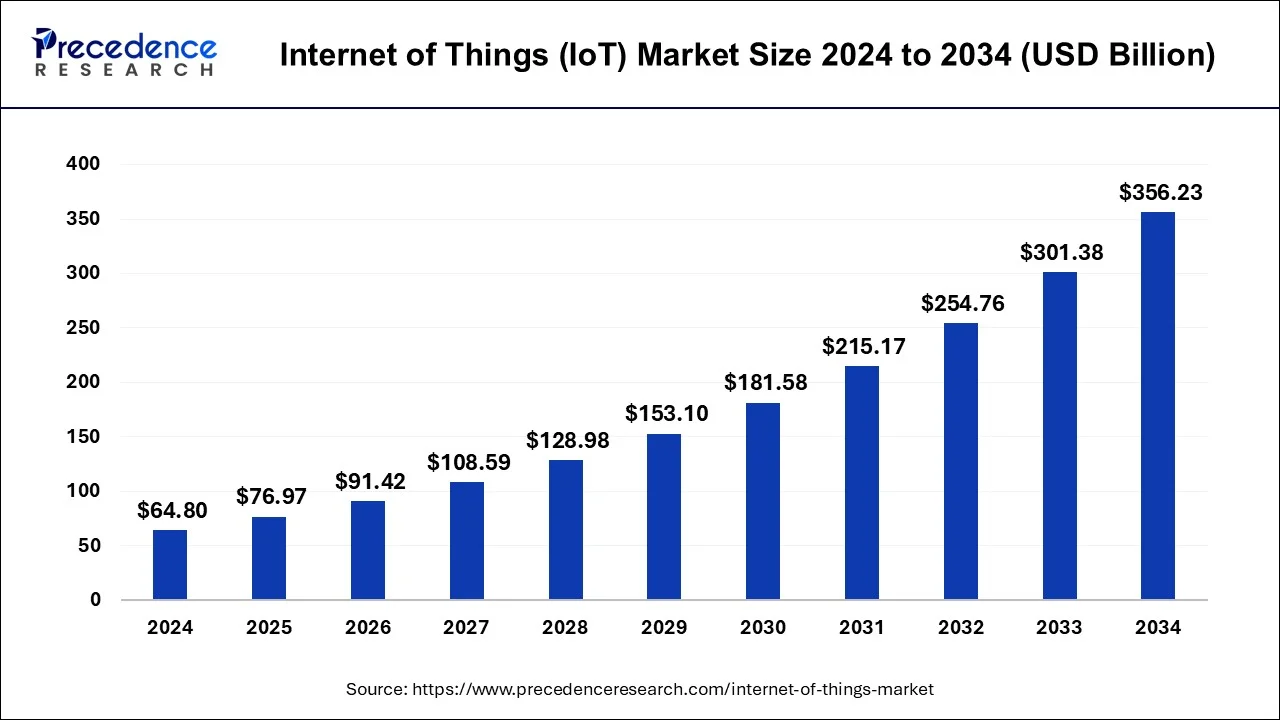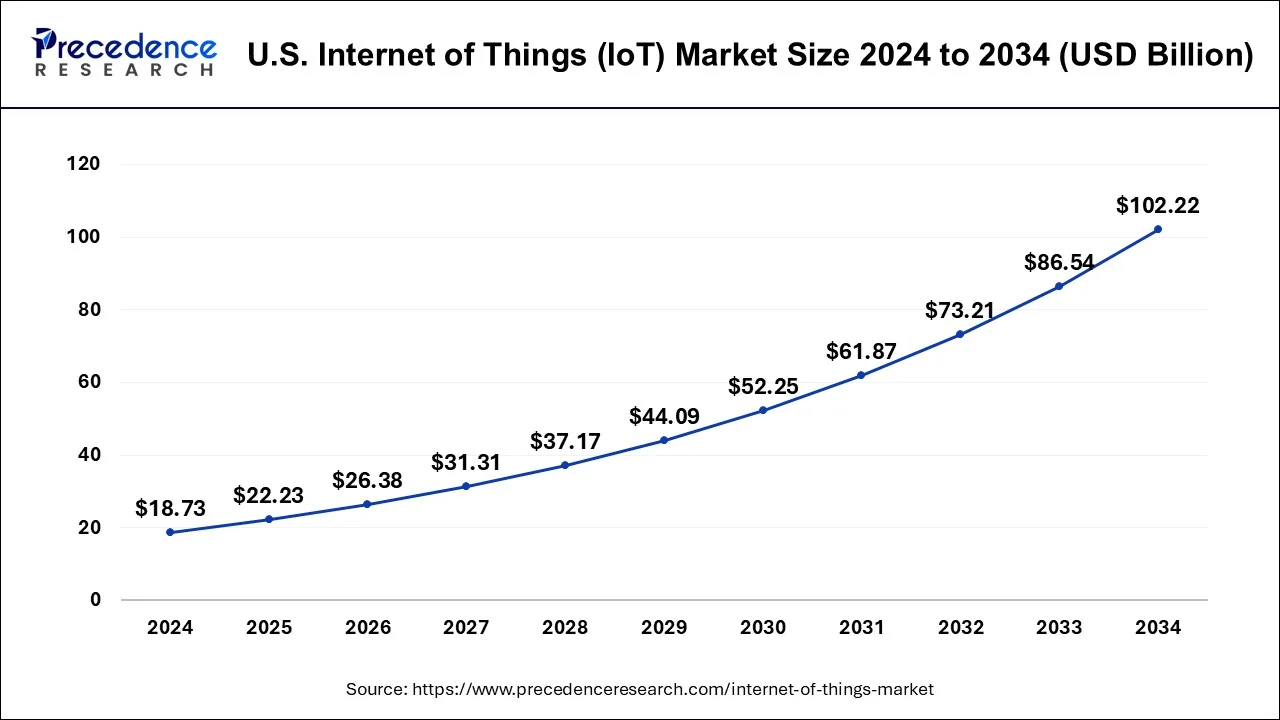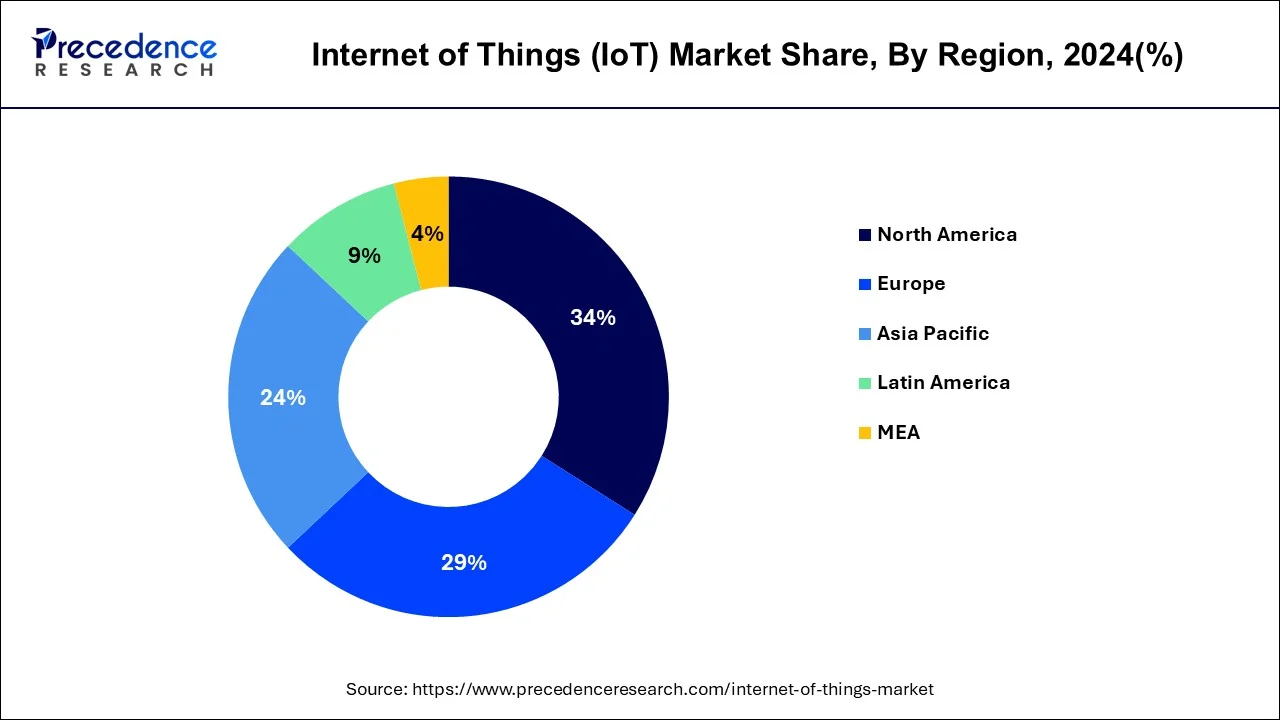List of Contents
Internet of Things (IoT) Market Size and Forecast 2025 to 2034
The global internet of things (IoT) market size was USD 64.80 billion in 2024, estimated at USD 76.97 billion in 2025 and is anticipated to reach around USD 356.23 billion by 2034, expanding at a CAGR of 18.56% from 2025 to 2034.

Internet of Things (IoT) MarketKey Takeaways
- North America led the global market with the highest market share of 34% in 2024.
- By Component, the software segment held the largest market share in 2024 and is expected to continue the same pattern during the forecast period.
- By Deployment, the cloud segment is expected to dominate the market during the forecast period.
- By Organization size, the large enterprises segment is expected to hold a significant market share over the forecast period.
- By Platform, the device management segment is expected to dominate the market over the forecast period.
- By Technology, the network communication segment is expected to grow at the fastest rate over the forecast period.
- By Industry Vertical, the e-commerce segment is expected to grow at the highest CAGR over the forecast period.
U.S.Internet of Things (IoT) Market Size and Growth 2025 to 2034
The U.S. internet of things (IoT) market size was estimated at USD 18.73 billion in 2024 and is projected to surpass around USD 102.22 billion by 2034 at a CAGR of 18.47% from 2025 to 2034.

North America is expected to dominate the market during the forecast period.This is due to the accelerating growth in smart device demand, expanding research into artificial intelligence and machine learning-based IoT solutions, increasing use of the Industrial Internet of Things (IIoT) in manufacturing, and a growing number of government initiatives for smart infrastructure and cities. Additionally, Internet of Things (IoT) applications are being developed at a rising rate in the North American nations' retail, healthcare, and agricultural industries, which is driving market expansion. Moreover, the presence of major players operating in the region is also one of the significant factors during the forecast period.
The United States currently occupies the largest share of the global IoT market due to its strong technology ecosystem, penetration of 5G technology, and innovation-driven businesses. Companies like AWS, Google Cloud, and Microsoft Azure are bundling IoT with AI and edge computing, particularly in areas like industrial automation and smart home applications. Also, strong cyber security best practices regarding IoT and early IoT deployment in high IoT usage sectors like manufacturing and healthcare also drive the increase in market growth. China:
China is one of something very noteworthy growth engines in the IoT space, because of government policy ambition like "Made in China 2025." China also has capitalized on smart city development, with the largest Io schönes investments into connected, urban infrastructure, surveillance, and IIoT. The presence of companies like Huawei, Alibaba, and Xiaomi also enable profitable and scalable IoT solutions into rural and urban markets. Germany:
As the home of IoT's Industry 4.0 movement - in Europe anyway - Germany has a very good track record of being at the leading edge of deploying IIoT technology. Germany's manufacturing sector continues to deploy IoT investments into enterprise systems for preventive maintenance, supplyihleaksgood, automating supply chain logistics, and digitizing factoryfv9e2ntory and therefore, factory operations. Increasingly, and thanks to more public sector investments into incubators and innovation hubs coupled with innovative pilot projects in smart factories - the deployment of manufacturing IoT is accelerating.

Asia Pacific is expected to grow at the highest CAGR during the forecast period.The market growth in the region is attributed to the increased investment, technology adoption and the proliferation of connected devices. Additionally, the growing product & services by the market players is another factor that propels the market growth in the region.
Asia Pacific dominates the Internet of Things (IoT) market. The high demand in regional markets of the market and the in-demand, continuous development of the technology rank Asia Pacific in first place. The social acceptance of the advancement empowers the region to educate businesses with the newest technology.
- For instance, in March 2023, A new cloud-based platform was made available, according to a release from Fujitsu, enabling users to safely gather and use health-related data to furtherdigital transformation in the medical industry. Fujitsu's new offering is a component of its continued efforts to support the development of a healthy society. Japanese hospitals and pharmaceutical firms will be able to use the new platform provided by Fujitsu. The new platform makes it possible to safely aggregate health-related data and automatically convert medical data from electronic medical records kept by medical facilities to comply with the HL7 FHIR standards framework. Thus, this is expected to drive the market growth in the region.
The IoT market in India is on a rapid growth trajectory, driven by the growing penetration of smartphones, inexpensive sensors, and government programs directing funding through initiatives such as Digital India and Smart Cities Mission. We are seeing an increase in adoption in agriculture, logistics, and energy management. Meanwhile, infrastructure gaps and data privacy challenges remain barriers.
Market Overview
The internet of things (IoT) refers to a network of interconnected physical objects, devices, machines, and other products that are embedded with sensors, software, and communication capabilities, allowing them to collect and exchange data with each other and with central systems over the internet. The primary objective of IoT is to enable these smart objects to gather information, make decisions, and interact with the physical world and digital systems, often without direct human intervention. IoT transforms everyday objects into intelligent entities that can monitor their environment, communicate with other devices, and perform actions based on data and commands received through the internet.
Technological Advancement
Technological advancements in the Internet of Things (IoT) market feature edge computing, 5G connectivity, AI and machine learning, digital twins, industrial IoT, smart cities, and blockchain. Edge computing reduces latency and helps the operational process work efficiently. Blockchain supports transactions and IoT data exchange by providing security and transparency. Industrial IoT is used in the manufacturing industry to optimize workflow and automate processes. Digital twins define physical assets, its being used to get exposure and optimize the real-world systems.
IoT-enhanced healthcare technology provides wearable devices and other IoT applications, which are encouraging the healthcare sector. AI and machine learning algorithms are merged with IoT devices and systems. It helps to detect anomalies, make decisions, and predict maintenance. The 5G networks enable quick and reliable communications for IoT devices, providing low-latency applications and real-time data transmission. IoT technology in smart cities is used to improve the waste management system and traffic management.
Internet of Things (IoT) Market Growth Factors
This interconnected network of devices spans various domains, including home automation, industrial automation, healthcare, agriculture, transportation, and more, offering a wide range of applications and benefits.
The market growth is driven by several factors including increasing demand for automation, rise in big data for data management, increasing research in cloud computing platforms, the emergence of artificial intelligence and machine learning, and growing government projects for smart cities and 5G technologies.
Market Scope
| Report Coverage | Details |
| Growth Rate from 2025 to 2034 | CAGR of 18.47% |
| Market Size in 2025 | USD 76.97 Billion |
| Market Size by 2034 | USD 356.23 Billion |
| Largest Market | North America |
| Base Year | 2024 |
| Forecast Period | 2025 to 2034 |
| Segments Covered | By Component, By Deployment, By Organization Size, By Platform, By Technology, and By Industry Vertical |
| Regions Covered | North America, Europe, Asia-Pacific, Latin America, and Middle East & Africa |
Market Dynamics
Driver
Growing application of IoT in the agriculture industry
The growing adoption of IoT in the agriculture sector is expected to drive the growth of the market during the forecast period. IoT provides several benefits to the farmers such as cost reduction, better data analytics and increased overall operational efficiency. IoT technology will help farmers grow better crops at lower costs. They can estimate crop water needs, assess the health of their herds, and gather environmental and equipment metrics with the aid of agriculture IoT devices.
The frequency of visits to inspect crop spraying, equipment operation, and the state of arable land will be decreased by an IoT-based agriculture monitoring system. A smart irrigation system will assist farmers in solving the problem of overwatered or overdried plants by accelerating production and exponential development. Farmers will be able to increase production efficiency, predictive data analytics, and pest management with the help of these environmental sensors. Thus, these benefits drive the IoT market over the projected period.
Restraint
Issues in technical integration and lack of network connectivity
Numerous applications for the IoT use machine learning and artificial intelligence technology. For IoT devices to mix and match and configure themselves autonomously to deliver different services in different situations, installation and setup with integration a difficult. Many developing nations struggle with the lack of essential technologies, including telecom and networking infrastructure, and are unable to quickly execute smart projects due to a variety of reasons, including poor investment and technical advancements. The research and development of 5G technologies are still happening in several nations. Even developed nations like Europe and North America struggle to replace their outdated infrastructures with modern ones. Thus, this factor is expected to hamper the market growth during the forecast period.
Opportunity
Development of smart cities
The development of smart city initiatives offers substantial opportunities for IoT applications. These include traffic management, waste management, energy conservation, public safety, and improved urban planning to create more sustainable and efficient cities. For instance, according to the data published by the India Brand Equity Foundation, the Smart City Mission's total allotted investments were worth US$27.60 billion. As of March 2021, 5,614 projects worth $ 23.29 billion have been bid and 2,420 projects worth $ 5.40 billion have been completed. Thus, the aforementioned facts drive the revenue growth of the market over the anticipated timeframe.
Component Insights
Based on the components, the global Internet of Things (IoT) market is segmented into hardware, software and services. The software segment held the largest market share in 2023 and is expected to continue the same pattern during the forecast period. This is due to the growth of software based on artificial intelligence and machine learning, the expansion of software deployments on the cloud, and the expanding demand for data management with visibility and control. To offer real-time data that computers and apps can convert and show as information, connected devices need IoT software for data collection and transfer. Software integrations come in many forms and are always evolving to keep up with new technology.
For instance, in May 2022, Visionstate launched the WANDATM family of IoT software tools, which are utilized in hospitals, seniors/aged care institutions, airports, shopping malls, and other public facilities across and beyond North America. Among the products offered are wandaNEXTTM and wandaMOBILETM. Thereby, driving the segment growth.
Deployment Insights
Based on the deployment, the global Internet of Things (IoT) market is segmented into cloud and on-premises. The cloud segment is expected to dominate the market during the forecast period. Cloud computing is an essential enabler of IoT solutions. It provides the infrastructure, data processing power, scalability, security, and cost-effectiveness needed to handle the massive amounts of data generated by IoT devices and to deliver actionable insights to businesses and consumers. As the IoT market continues to grow, cloud services will likely remain a fundamental component of IoT ecosystems. Thus, this is expected to drive the market growth during the forecast period.
Organization Size Insights
Based on the organization size, the global Internet of Things (IoT) market is segmented into large enterprises and SMEs. The large enterprises segment is expected to hold a significant market share over the forecast period. Large enterprises use IoT to optimize their operations. For instance, manufacturing companies employ IoT for predictive maintenance, reducing equipment downtime and maintenance costs. IoT solutions in supply chain management help streamline logistics, reduce inventory carrying costs, and enhance resource allocation.
Moreover, it generates vast amounts of data that can be analyzed to derive actionable insights. Large enterprises leverage this data to make data-driven decisions, enhance strategies, and improve business processes. Furthermore, IoT enables large enterprises to offer enhanced customer experiences. For instance, in the retail sector, IoT-driven personalized marketing and in-store experiences can attract and retain customers. Thus, these benefits of IoT drive the segment growth.
Platform Insights
Based on the platform, the global internet of things (IoT) market is segmented into device management, application management and network management. The device management segment is expected to dominate the market over the forecast period. Device management is a critical component of the IoT (Internet of Things) market, as it involves the efficient and secure management of a wide range of IoT devices, sensors, and endpoints. Effective device management is essential for ensuring the reliability, security, and scalability of IoT deployments.
This solution facilitates the process of onboarding and provisioning IoT devices onto the network. This includes assigning unique identifiers, configuring device settings, and ensuring secure connectivity. In addition, large-scale IoT deployments, especially in industries like manufacturing and logistics, require comprehensive inventory management. Device management systems track device types, locations, and statuses, ensuring accurate asset management. Thereby, driving the segment growth.
Technology Insights
Based on the technology, the global internet of things (IoT) market is segmented into radiofrequency identification, pressure sensors, network communications, data processing and near-field communication. The network communication segment is expected to grow at the fastest rate over the forecast period. Network communication is a fundamental aspect of the IoT (Internet of Things) market, as it enables devices, sensors, and endpoints to connect, share data, and communicate with each other and with central systems.
Industry Vertical Insights
Based on the industry vertical, the global internet of things (IoT) market is segmented into energy & utility, healthcare, transportation & logistics, IT & telecom, manufacturing, e-commerce and others. The e-commerce segment is expected to grow at the highest CAGR over the forecast period. The integration of IoT in e-commerce is transforming the way businesses operate, enhancing customer satisfaction, improving supply chain efficiency, and enabling more personalized shopping experiences. As the IoT market continues to evolve, e-commerce companies will likely explore innovative ways to leverage IoT technology to gain a competitive edge and meet the changing demands of online shoppers. Thus, driving the market growth.
Internet of Things (IoT) Market Companies
- Intel Corporation
- Hewlett Packard Enterprise
- Sap SE
- Bosch Software Innovation
- Amazon Web Service
- Microsoft Corporation
- Oracle Corporation
- Cisco Systems, Inc.
- IBM Corporation
Recent Developments
- In February 2025, several pivotal strategic moves reshaped the sector: a leading cloud provider acquired a prominent IoT analytics firm to bolster its data processing suite; a major telecom company acquired an edge computing startup to reduce latency for smart devices; and an industrial automation giant added an IoT-security specialist to address escalating device vulnerabilities.
(Sources- https://cloudindustryreview.com) - In December 2024, Chinese IoT modules entered the government's radar. The component of the telecom network equipment is absent from India's stringent security checks of imports from China. India is increasing security on Chinese imports.
- In October 2024, the healthcare Internet of Things IoT system was implemented for COVID-19 prevention. The response to the widespread transmission of COVID-19 in Australia, healthcare facilities have introduced stringent infection control measures.
- In October 2024, Huawei participated in the first in-person Internet of Things architecture working group meeting on IEEE P2413.2, with a standard for reference architecture for power distribution.
- In June 2023, a collaborative digitalization and industrial IoT lab was opened in Hangzhou, China, by ABB and China Telecom. The joint effort between China Telecom's Internet of Things subsidiary E Surfing IoT and ABB Measurement & Analytics China Technology Center will concentrate on creating comprehensive industrial IoT solutions for Chinese-based industrial businesses.
- In April 2023, The Qualcomm QCS8550, Qualcomm QCM8550, Qualcomm QCS4490, and Qualcomm QCM4490 Processors were introduced by Qualcomm Technologies, Inc. to support the development of next-generation IoT devices. To satisfy the requirements of demanding industrial and commercial IoT applications, the new and improved solutions offer a range of capabilities, cutting-edge features, and adaptability. The IoT ecosystems in important industries like video collaboration, cloud gaming, retail, and others are continuing to grow due to new use cases across the solutions.
Segments Covered in the Report
By Component
- Hardware
- Software
- Services
By Deployment
- Cloud
- On-premises
By Organization Size
- Large Enterprises
- SMEs
By Platform
- Device Management
- Application Management
- Network Management
By Technology
- Radiofrequency Identification
- Pressure Sensors
- Network Communications
- Data Processing
- Near-field Communication
By Industry Vertical
- Energy & Utility
- Healthcare
- Transportation & Logistics
- IT & Telecom
- Manufacturing
- E-commerce
- Others
By Geography
- North America
- Europe
- Asia-Pacific
- Latin America
- Middle East and Africa
For inquiries regarding discounts, bulk purchases, or customization requests, please contact us at sales@precedenceresearch.com
Frequently Asked Questions
Ask For Sample
No cookie-cutter, only authentic analysis – take the 1st step to become a Precedence Research client